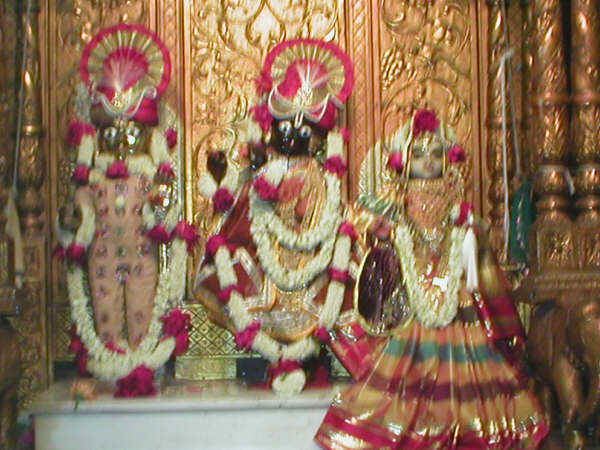 | ||
Goloka (Goloka Vrindavana or Gokula) is the supreme loka which is the king of all loka and is the eternal Supreme Abode of goddess Radha rani according to Vaishnava schools, including Gaudiya Vaishnavism and the Swaminarayan Sampraday. The scriptural basis for this comes from texts like Narada Pancaratra, Garga Samhita, Brahma Samhita and Brahma vaivarta. Among all 18 puranas, Brahma vaivarta purana explicitly describes about Goloka vrindavan throughout its all contents.
Contents
While in most of the Bhagavata Purana, Krishna is presented as the cosmic Vishnu, the Supremely Powerful God. He is especially portrayed as the highest person who resides in his abode Goloka according to the interpretation of Jiva Goswami.
In the Bhagavata Purana, Krishna states that he shall ascend to his eternal supreme abode, Vaikuṇṭha, after the purpose of his incarnation is accomplished.
According to some sources, Goloka is part of Vaikuṇṭha, while other sources claim that Goloka is a highest planet or realm (loka) of the Vaikuṇṭha planets for the devotees of Krishna, who is known as the protector of cows; hence, the latter are found in abundance in Goloka. Also sometimes referred to as Vrindavan, it is described as a land of plenty, rich with natural beauty.
One standard Vaishnava description of Goloka is found at verse 5.29 of the Brahma-Samhita: "I worship Govinda, the primeval Lord, the first progenitor, who is tending the cows, yielding all desires, in abodes built with spiritual gems and surrounded by millions of purpose trees. He is always served with great reverence and affection by hundreds and thousands of devotees resembling goddesses of fortune." Similarly, Gaudiya Vaishnava saint-scholar Śrĩla Sanãtana Goswãmĩ declares: "Sri Goloka is considered the ultimate destination of spiritual endeavour."
In Goloka Krishna resides with Radharani, Krishna's eternal consort, and countless other devotees, wherein he performs his divine play, known as lila. It is believed that mortal or "conditoned" souls return to the material world again and again to perfect themselves before going on to Krishna's abode, known as the Vaikunthas. However, Goloka Vrndavana is the topmost of all the planets in either the material or spiritual worlds, and rare is the soul who is allowed to go there.
According to Hindu scriptures, the term Goloka is synonymous with Vaikuntha and Saket Loka.
Etymology
Goloka means the world of cows. The Sankrit word 'go' can refer to either cows or star, and loka is translated as world or planet.
In the Vedas and Upanishads there is no direct mention of Goloka. Nevertheless it does not refutes authenticity of "Goloka" from the Canon of vedic literatures. In Brahma vaivarta purana, which is one of the 18 major puranas describes Goloka vrindavan to be 500 million yojanas(4000000000miles) above Vaikuntha loka and it expands till 30 million yojanas(240000000miles). This depiction could be similize with a verse found in brahma samhita 5.43. However Acharyas of Gaudiya Vaishnavaism explains it to be limitless. Further statements declares, Both Vaikuntha and Goloka to be Nitya Dhama or eternal realm of existence. Which are not prone to annihilation even after the whole cosmic dissolution. Lord Krishna in his two-armed form eternally reside in the realm of Goloka and in his four-armed form, as Lord Vishnu he eternally resides in the realm of Vaikuntha loka.
Mention of Goloka is also found in other Puranas, such as Skanda Purana and Markandeya Purana.
Evam bahu-vidhai rupais
caramiha vasundharam brahmalokam ca kaunteya golokam ca sanatanam.
"O son of Kuntī, in many different forms I wander in the material world, in the spiritual world, and in the eternal realm of Goloka."
In Brihad-bhagavatamrita, Srila Sanatana Goswami explains this verse is quoted from Skanda Purana and it is spoken by Lord Krishna to Arjuna.
In the Markandeya Purana, the Supreme Personality of Godhead declares:
Golokam ca parityajya
lokanam trana-karanat kalau gauranga-rupena lila-lavanya-vigrahah.
"In the Kali-Yuga, I will leave Goloka and, to save the people of the world, I will become the handsome and playful Lord Gauranga."
Gaulokvihari
In some temples, such as the Shri Swaminarayan Mandir Mumbai, the murtis installed are those of Shri Gaulokvihari and Radhikaji. Gaulokvihari is Krishna, (vihari means "a resident of"; hence, one of Krishna's names, as a resident of Goloka, is Gaulokvihari) and Radhika is Radha, his consort.
Krsnaloka structure
All the Vaikuntha planets are said to be like petals of a lotus flower, and the principal part of that lotus, called Krsnaloka or Goloka Vrndāvana, is the center of all the Vaikunthas. Thus the expansions of Krsna in various forms, as well as His various abodes on the spiritual planets in the spiritual sky, are unlimited. Krsnaloka is divided into three different portions: Gokula, Mathurā and Dvārakā. As stated in Brahma-samhitā (5.43), all the Vaikuntha planets in the spiritual sky (known as Vishnuloka) emanate from the predominating Deity of Krsnaloka, Goloka Vrndāvana, known as Bhagavan.
